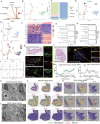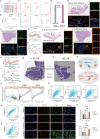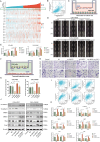Spatiotemporal heterogeneity of LMOD1 expression summarizes two modes of cell communication in colorectal cancer
- PMID: 38849852
- PMCID: PMC11161970
- DOI: 10.1186/s12967-024-05369-3
Spatiotemporal heterogeneity of LMOD1 expression summarizes two modes of cell communication in colorectal cancer
Abstract
Cellular communication (CC) influences tumor development by mediating intercellular junctions between cells. However, the role and underlying mechanisms of CC in malignant transformation remain unknown. Here, we investigated the spatiotemporal heterogeneity of CC molecular expression during malignant transformation. It was found that although both tight junctions (TJs) and gap junctions (GJs) were involved in maintaining the tumor microenvironment (TME), they exhibited opposite characteristics. Mechanistically, for epithelial cells (parenchymal component), the expression of TJ molecules consistently decreased during normal-cancer transformation and is a potential oncogenic factor. For fibroblasts (mesenchymal component), the expression of GJs consistently increased during normal-cancer transformation and is a potential oncogenic factor. In addition, the molecular profiles of TJs and GJs were used to stratify colorectal cancer (CRC) patients, where subtypes characterized by high GJ levels and low TJ levels exhibited enhanced mesenchymal signals. Importantly, we propose that leiomodin 1 (LMOD1) is biphasic, with features of both TJs and GJs. LMOD1 not only promotes the activation of cancer-associated fibroblasts (CAFs) but also inhibits the Epithelial-mesenchymal transition (EMT) program in cancer cells. In conclusion, these findings demonstrate the molecular heterogeneity of CC and provide new insights into further understanding of TME heterogeneity.
Keywords: Colorectal cancer; Epithelial cells; Fibroblasts; Gap junctions; LMOD1; Tight junctions.
© 2024. The Author(s).
Conflict of interest statement
The authors declare no conflicts of interest. All authors contributed to data analysis, drafting, or revising of the article; agree on the journal to which the article is being submitted; provided final approval of the version to be published; agree to be accountable for all aspects of the work.
Figures








Similar articles
-
TRIP6 disrupts tight junctions to promote metastasis and drug resistance and is a therapeutic target in colorectal cancer.Cancer Lett. 2023 Dec 1;578:216438. doi: 10.1016/j.canlet.2023.216438. Epub 2023 Oct 11. Cancer Lett. 2023. PMID: 37827326
-
BVES regulates EMT in human corneal and colon cancer cells and is silenced via promoter methylation in human colorectal carcinoma.J Clin Invest. 2011 Oct;121(10):4056-69. doi: 10.1172/JCI44228. Epub 2011 Sep 12. J Clin Invest. 2011. PMID: 21911938 Free PMC article.
-
CAFs secreted exosomes promote metastasis and chemotherapy resistance by enhancing cell stemness and epithelial-mesenchymal transition in colorectal cancer.Mol Cancer. 2019 May 7;18(1):91. doi: 10.1186/s12943-019-1019-x. Mol Cancer. 2019. PMID: 31064356 Free PMC article.
-
Gap junction as an intercellular glue: Emerging roles in cancer EMT and metastasis.Cancer Lett. 2016 Oct 10;381(1):133-7. doi: 10.1016/j.canlet.2016.07.037. Epub 2016 Aug 1. Cancer Lett. 2016. PMID: 27490999 Review.
-
A Holistic Appraisal of Stromal Differentiation in Colorectal Cancer: Biology, Histopathology, Computation, and Genomics.Pathol Res Pract. 2021 Apr;220:153378. doi: 10.1016/j.prp.2021.153378. Epub 2021 Feb 13. Pathol Res Pract. 2021. PMID: 33690050 Review.
Cited by
-
Multi-omics analysis identifies DLX4 as a novel biomarker for diagnosis, prognosis, and immune infiltration: from pan-cancer to renal cancer.Discov Oncol. 2025 Apr 5;16(1):467. doi: 10.1007/s12672-025-02258-z. Discov Oncol. 2025. PMID: 40186710 Free PMC article.
-
Breaking down physical barriers: strategies to improve lymphocyte infiltration for effective neoantigen-based therapies.Front Immunol. 2025 Jun 12;16:1614228. doi: 10.3389/fimmu.2025.1614228. eCollection 2025. Front Immunol. 2025. PMID: 40574854 Free PMC article. Review.
References
MeSH terms
Substances
Grants and funding
- ZDXYS202208/Jiangsu Provincial Medical Key Laboratory
- 82205212/Natural Science Foundation of China
- 82174379/Natural Science Foundation of China
- 035062005002-11/Advantageous Disciplines of Jiangsu Province
- y2021rc19/Jiangsu Province Hospital of Chinese Medicine Peak Academic Talent Project
- ZD2022070/Jiangsu Provincial Health and Medical Committee Key Projects
- Y2020CX62/Science and Technology Program of the Affiliated Hospital of Nanjing University of Traditional Chinese Medicine
- Y2020CX38/Science and Technology Program of the Affiliated Hospital of Nanjing University of Traditional Chinese Medicine
- 20085-9-3/State Administration of Traditional Chinese Medicine Program
- SJCX230886/Jiangsu Provincial Degree Committee and Jiangsu Provincial Department of Education
- SJCX220710/Jiangsu Provincial Degree Committee and Jiangsu Provincial Department of Education
- JD2023SZ04/National Clinical Research Base of Tradiional Chinese Medicine in Jiangsu Province
- JD2023SZ0/National Clinical Research Base of Tradiional Chinese Medicine in Jiangsu Province
- KYCX23-2169/Jiangsu Postgraduate Research Innovation Program
LinkOut - more resources
Full Text Sources
Medical
Molecular Biology Databases
Miscellaneous

